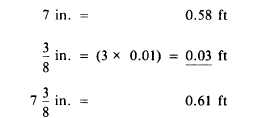To convert (for example) 7 3/8 in. carpenter’s
measure to engineer’s measure, you have the
following:
For a great many types of conversions there
are tables in which you can find the desired values
by inspection. Various publications contain tables
for making the following conversions:
Meters to feet
Feet to meters
Degrees Centigrade to degrees Fahrenheit
Degrees Fahrenheit to degrees Centigrade
Inches and sixteenths to decimals of a foot
Sixteenths of an inch to decimals of a foot
Minutes to decimals of a degree
Degrees to roils and roils to degrees
Grads to degrees, minutes, and seconds
A conversion factor is a number that, if
multiplied by a value expressed in terms of
one unit, will produce the equivalent value ex-
pressed in terms of a different unit. The factor for
converting linear feet to miles, for instance, is
0.00019. If you multiply 5,280 ft by 0.00019, you
get 1.0032 miles, which is close enough to a mile
to satisfy most practical purposes.
When you know the ratio between two
different units, you can easily work out your
conversion factor. For example, you know that
the ratio of degrees to roils is
The conversiom factor for converting degrees to
roils is the number of roils in 1 degree, which is
The conversion factor converting roils to degrees
is the number of degrees in a roil, which is
Some of the common conversion factors are
as follows :
Linear feet x 0.00019
Linear yards x 0.0006
Square inches x 0.007
Square feet x 0.111
Square yards x 0.0002067
Acres x 4840.0
Cubic inches x 0.00058
Cubic feet x 0.03704
= miles
= miles
= square feet
= square yards
= acres
= square yards
= cubic feet
= cubic yards
1-35

